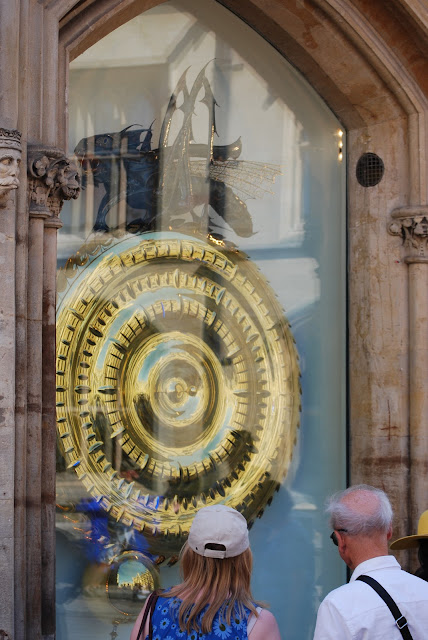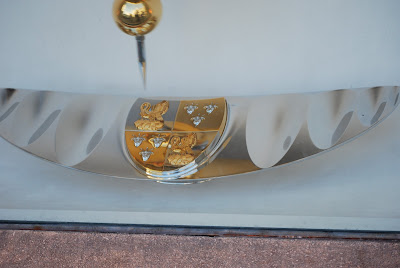Now, admittedly, the arms of Gonville and Caius (pronounced "Kees") College are especially complex because they consist of the impaled arms, within a bordure compony, of the first founder, Edmund Gonville, and the third founder, Dr. John Caius. (The second founder, Bishop William Bateman, is commemorated heraldically in his own separate foundation of Trinity Hall, as we have already seen.)
Gonville Hall was founded in 1348 by Edmund Gonville, Rector of Terrington (near Lynn). When he died just three years later, in 1351, his friend and executor Bishop Bateman drew up a new set of statues and changed the name to the Hall of the Annunciation of the Blessed Virgin Mary. John Caius, a native of Norwich, graduated from the College in 1533, going on to study medicine at Padua and graduating M.D. On his return to London, he offered to indirectly endow Gonville Hall, but discovering that it had never been properly incorporated, he obtained a Royal Charter of foundation and confirmation of past acts in 1557. This renamed the hall Gonville and Caius College. Shortly afterwards, Dr. Caius was elected Master, and retained this position until shortly before his death in 1573.
And, indeed, we can find the arms of the first and third founders displayed separately on the façade of the College:
And marshaled, as noted above, in monotone. It was in the Visitation of 1575 that Robert Cooke, Clarenceux King of Arms added the bordure compony to avoid the impression that the arms did not suggest a marriage between the two families of Gonville and Caius, thus creating a unified and distinctive shield for the foundation.
But it's when we start seeing it in color that we begin to truly grasp its complexity:
But before moving on to the final, full-color rendition, let's take a look at the blazon:
Argent on a chevron between two couple closes indented sable three escallops or (Gonville), impaling Or semy of flowers gentle in the middle of the chief a sengreen resting upon the heads of two serpents in pale their tails knit together all proper resting upon a square marble stone vert between their breasts a book sable garnished gules buckled or (Caius), all within a bordure compony argent and sable.
Heraldically, serpents proper are usually vert, or green; the flowers gentle (floramor) are usually shown as argent, or white; and sengreen (the houseleek in flower) ought to be a pink flower with green leaves, but is usually drawn as argent, or white.
Dr. Caius explains the meaning of his coat of arms, which he obtained in January 1560 [Old Style]/1561 [New Style]* from Laurence Dalton, Norroy King of Arms:
betokening by the book learning, by the ii serpentes resting upon the square marble stone, wisdome with grace founded and styed upon vertues stable stone; by sengrene and flower gentile, immorality that never shall fade, as though thus I shulde saye, ex prudentia et literis, virtutis, petra firmatis immortalitas, that is to say, by wisdome and lerning graffed in grace and vertue, men cum to immortalite.
And now, just so that you can get the full impact of the College's coat of arms, here it is in full color over the main gateway:


As you can see, they've added some green to both the sengreen and the flowers gentle, presumably to help their contrast against the gold field, but totally missed that the serpents ought to be green!
Oh, well, that default is a bit obscure.
* Until 1752 in England, the new year began on March 25 (following the Julian calendar); in 1752 the beginning of the new year was changed to January 1 (to follow the Gregorian calendar). Dates prior to 1752 falling between January 1 and March 25 are generally now written as, for example, February 2, 1660/61, or as February 2, 1660 (O.S.)/1661 (N.S.) to indicate that the date was considered to have occurred in the year 1660 then, but would now be considered to have occurred in the year 1661.
You can learn all kinds of weird stuff by following this blog, can't you?










































